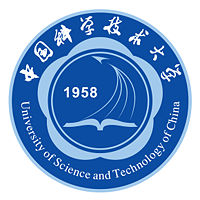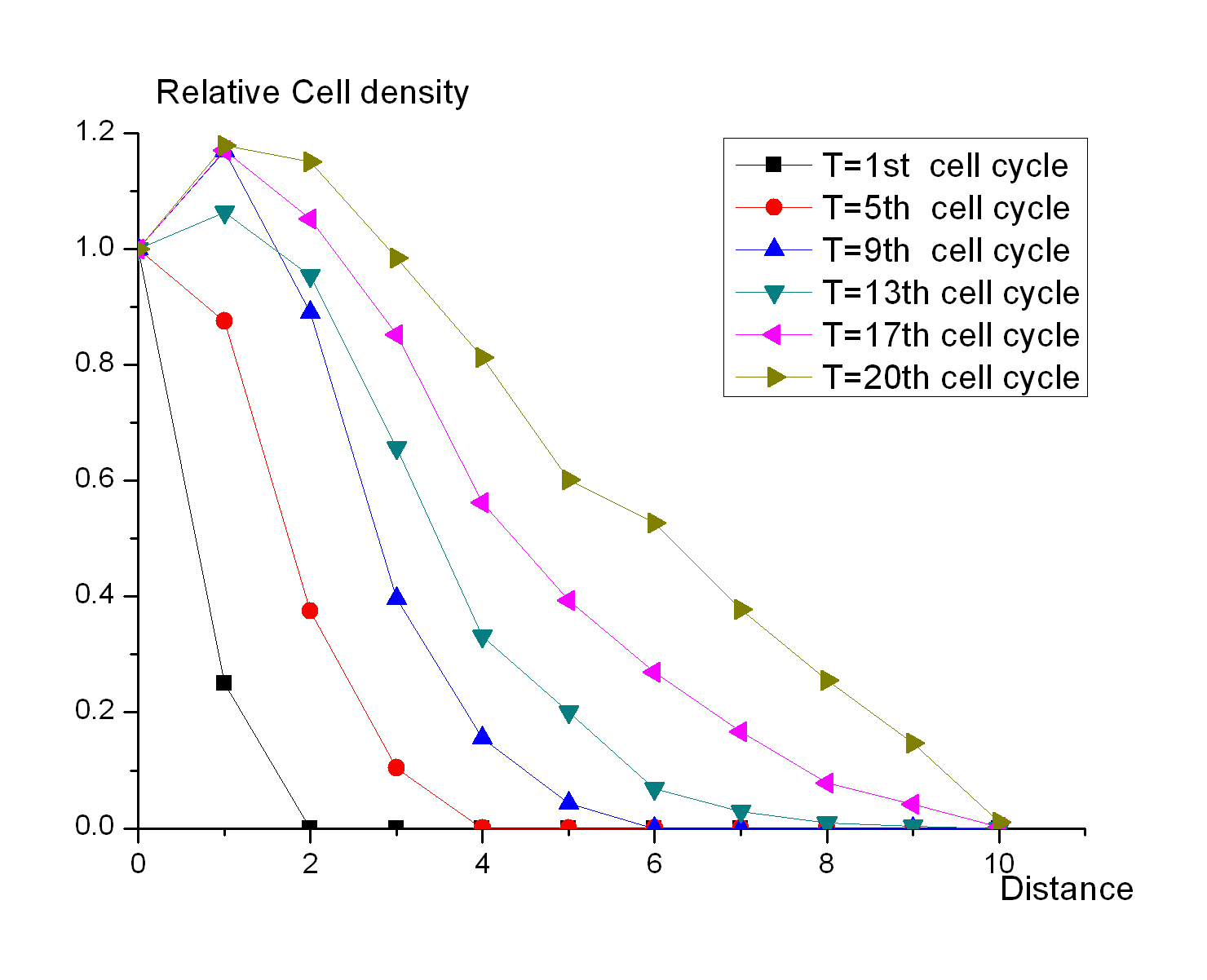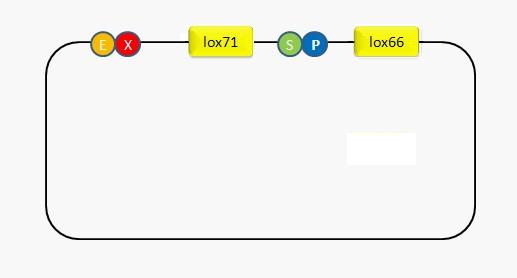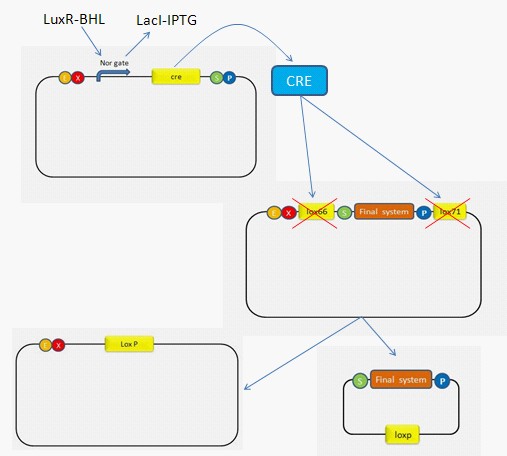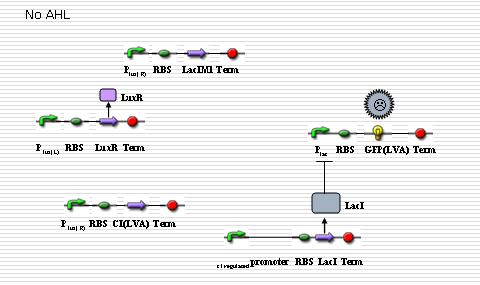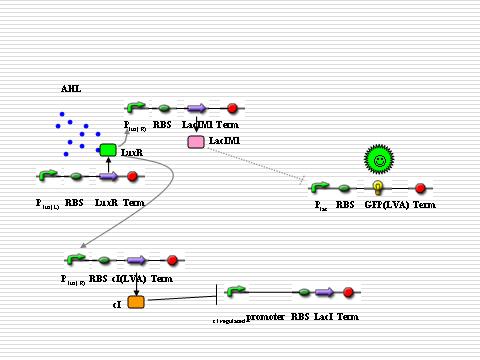Team:USTC/Component
From 2008.igem.org
(→Report Component) |
|||
| Line 96: | Line 96: | ||
In “sender” cells, the tetR promoter expresses LuxI constitutively so that an AHL gradient is built up around the senders. When the AHL concentration reaches a certain level, the LuxR promoter is activated to a large extent so that LacIM1 protein (a mutant of LacI) and cI protein will be expressed in a large amount. The cI protein will shut off the expression of LacI while the LacIM1 protein will inhibit the expression of GFP regulated by LacR promoter. When the AHL concentration is intermediate, the cI protein is still capable to stop the LacI expression while the LacIM1 protein can not inactivate the LacR promoter any longer, so a certain level of GFP can be observed. On the other side, when the AHL concentration is too low, neither cI nor LacIM1 will be expressed. Without cI protein, the lambda promoter will be activated and LacI protein is produced, which inactivates the LacR promoter so that GFP could be barely observed. All the above are shown as the figures below. | In “sender” cells, the tetR promoter expresses LuxI constitutively so that an AHL gradient is built up around the senders. When the AHL concentration reaches a certain level, the LuxR promoter is activated to a large extent so that LacIM1 protein (a mutant of LacI) and cI protein will be expressed in a large amount. The cI protein will shut off the expression of LacI while the LacIM1 protein will inhibit the expression of GFP regulated by LacR promoter. When the AHL concentration is intermediate, the cI protein is still capable to stop the LacI expression while the LacIM1 protein can not inactivate the LacR promoter any longer, so a certain level of GFP can be observed. On the other side, when the AHL concentration is too low, neither cI nor LacIM1 will be expressed. Without cI protein, the lambda promoter will be activated and LacI protein is produced, which inactivates the LacR promoter so that GFP could be barely observed. All the above are shown as the figures below. | ||
| - | + | [[Image:USTC_exp_1.jpg|left|300px|thumb|Fig 4.The low concerntration condition]] | |
| + | [[Image:USTC_exp_2.jpg|left|300px|thumb|Fig 5.The medium concerntration condition]] | ||
| + | [[Image:USTC_exp_1.jpg|left|300px|thumb|Fig 6.The high concerntration condition]] | ||
== Acknowledgement== | == Acknowledgement== | ||
Revision as of 16:04, 28 October 2008
| Home | The Team | The Project | Components | Parts Submitted to the Registry | Notebook |
|---|
Contents |
Differetiate Component
We design a time-dependent gene regulation system to construct a self-organized system. The RhlL/RhlR system is employed to report the cell-population density. The sender cell will appear first when the density reaches a certain level. And it will tell other cells around it to be the receiver cells by sending the ligands to environment. After receiving the ligands, the Cre recombinase will be expressed to eliminate the function of sending ligands. In this way, a positional differentiation will be done.
The cell density of the colony on the plate
Cell Automata is employed to mimic the states of a colony growing on the plate. The first seed is placed on the center of the table. Each seed has a child in the next generation, and the child seed is randomly putted into the grid next to its parent. It is the simplest simulation, but it can suggest how the bacteria grow on the plate when the resources are affluent. Fig 1 shows the changes of cell relative density related to the distance at different time points.And the result shows that 1) the colony can be divided into two parts, the central region and the peripheral region, according to the density of cells; 2) the central region will expand during the growth of the colony; 3) the difference between the peripheral region and the central region is evident enough to be sensed by the concentration of signal molecules.
Quorum Sensing System
RhlI/RhlR, one type of quorum sensing systems, is employed as messengers to inform the cell of the local environment where it lives. RhlI is the enzyme that catalyzes the synthesis of C4HSL and RhlR is the receptor of C4HSL. If the concentration of C4HSL reaches a certain level, the RhlR will elevate the expression level of downstream genes of RhlR promoter to a great extent. It marks the initiation of differentiation. There are three genes downstream: RhlI, LuxI and LacI. RhlI can upregulate the expression of downstream genes by forming a positive feedback system. The LuxI gene is transcribed to synthesize the signal molecule AHL, sending the differentiation order to other cells. However, LacI acts against AHL inhibiting the expression of differentiation executor. In order to build the system, we have designed and constructed several protein-coding units as follows:
1. K082035
In this sequence, we ligated the ptetR, RBS, RhlI, terminator together, so as to produce the C4HSL constitutively. The sequencing results and the electrophoresis both demonstrate that the sequence of the unit is correct. Moreover, although it is too difficult for us to directly test whether RhlI can generate C4HSL as we wish as we could not obtain the purified C4HSL molecule, we constructed another sequence comprised by ptetR, RBS, RhlI, RBS, GFP and terminator. The green fluorescence we have observed confirmed the normal expression of RhlI indirectly. We have designed and constructed several protein-coding units。.
2. K082021
The sequence codes for RhlR protein and the protein is constitutively expressed.
3. K082020
Similarly, the sequence expresses the Lux R protein constitutively.
4. K082045
This is the initiation part of differentiation in our project. The sequence codes for RhlI, LacI and LuxI and expresses them at a high level only when there are both RhlR and C4-HSL present. In our design, we hope the concentration of C4-HSL increases to a certain amount but not too much, so a weaker RBS is used. Moreover, the proteins Lac repressor and AHL are also generated.
NOR gate && Cre recombinase
NOR Gate
The executor part of differentiation is the Cre recombinase that is regulated by a NOR gate. The designed NOR gate is regulated by two proteins: LacI and LuxR. NOR gate will only be turned on with AHL present and LacI absent. Here the logical gate is utilized to distinguish whether the signal molecule is endogenic or ectogenic. At the beginning, the expression will be inhibited by LuxR. Once LuxI is expressed, AHL will be synthesized and spread in the colony. If AHL is endogenic, LacI will be also expressed so that the executor is not expressed. If AHL is ectogenic, before the concentration of LacI in the cell reaches a sufficient level, the NOR gate is turned on and the executor will be expressed, leading to the shutting off of the AHL generator.
| LuxR | LacI | Exp |
| 0 | 0 | 1 |
| 1 | 0 | 0 |
| 0 | 1 | 0 |
| 1 | 1 | 0 |
Recombinase
In order to utilize the recombination system repetitively, we design an adaptor where we can put in any part that needs recombining. To accomplish this goal, the restriction sites of SpeI and PstI are placed between lox66 and lox71. In this way, any fragment digested by XbaI and PstI can be inserted between the two recombination sites. We locate the recombination sites into the blank plasmid pSB3C5. The sequencing result as well as the insertion of GFP proves that the system can work successfully.(Fig2,Fig3)
Report Component
The response to distance requires that the reporter gene only responds to a narrow range of signal concentrations, which means the reporter gene will not be expressed when the concentration of signals is either too high or too low. There are some different ways to deal with the problem:
Multi-regulatory system
The idea comes from the Nature letter “A Synthetic Multicellular System for Programmed Pattern Formation”. In this paper, based on quorum sensing, the engineered ‘receiver’ cells are programmed to form ring-like patterns while the chemical gradient of the acyl-homoserine lactone signal synthesized by ‘sender’ cells is formed. The ‘sender’ and ‘receiver’ cells can be organized to our system.
In “sender” cells, the tetR promoter expresses LuxI constitutively so that an AHL gradient is built up around the senders. When the AHL concentration reaches a certain level, the LuxR promoter is activated to a large extent so that LacIM1 protein (a mutant of LacI) and cI protein will be expressed in a large amount. The cI protein will shut off the expression of LacI while the LacIM1 protein will inhibit the expression of GFP regulated by LacR promoter. When the AHL concentration is intermediate, the cI protein is still capable to stop the LacI expression while the LacIM1 protein can not inactivate the LacR promoter any longer, so a certain level of GFP can be observed. On the other side, when the AHL concentration is too low, neither cI nor LacIM1 will be expressed. Without cI protein, the lambda promoter will be activated and LacI protein is produced, which inactivates the LacR promoter so that GFP could be barely observed. All the above are shown as the figures below.
 "
"
